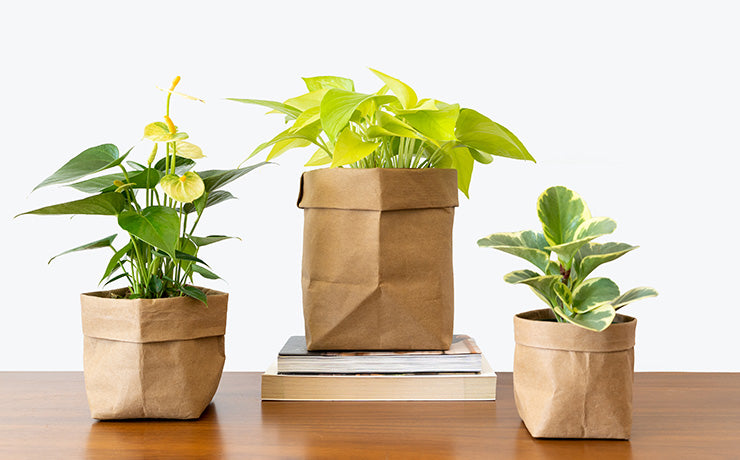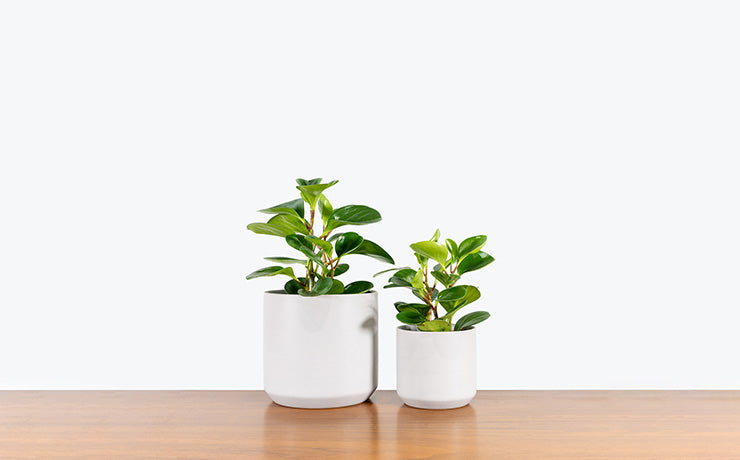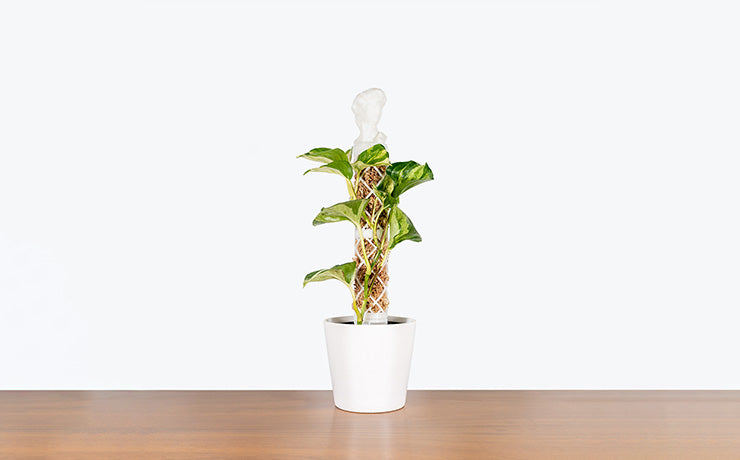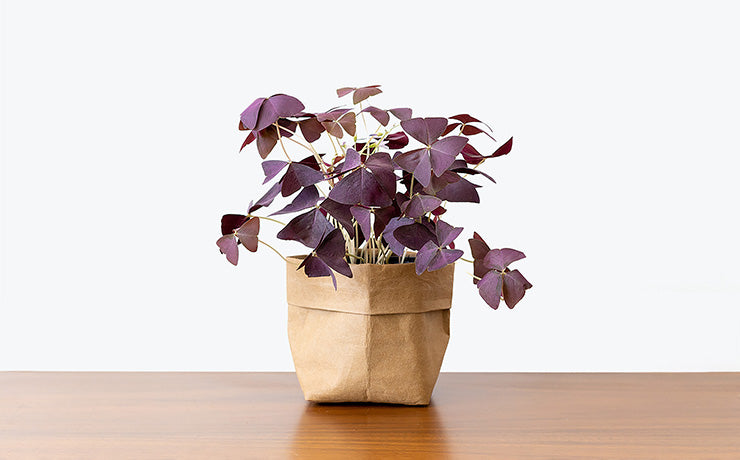Glossary
Plant Care Library
Z
ZZ Chameleon
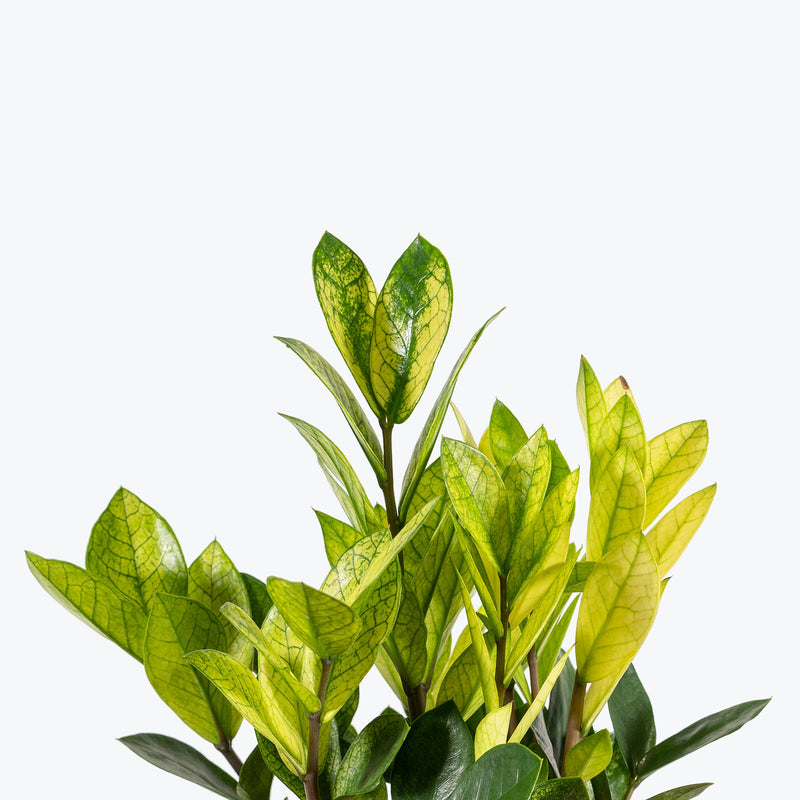
How to care for ZZ Chameleon
ZZ Chameleon should not be in a position to see the sun directly, although early morning or late evening sun is fine. Filtered sunlight through a sheer curtain is best and most homes are comprised primarily of indirect sunlight. The best spot for them is where they do not see the sun during the majority of the day but still get bright, indirect light.
ZZ Chameleon will do well in low light, but will grow faster with brighter light. A low light plant can pretty much survive anyplace inside your home as long as you have a window in the room. Remember, low light does not mean no light and plants will grow based on how much light they receive.
ZZ Chameleon likes the soil to be completely dry before the next watering. This can take up to 4 weeks in an average home environment but it will vary depending on the time of year, your environment and lighting conditions. For them, it's always safer to underwater or water when you see signs of lack of water (i.e. wrinkly or soft leaves). Water a little more often in the warmer months.
Their humidity requirement is low, so do not mist ZZ Chameleon or put them in a terrarium.
ZZ Chameleon is generally pest-resistant, but keep an eye out for signs of distress that could indicate a pest problem. Dust the leaves occasionally to keep them shiny and healthy. They are a slow grower, but as long as you don't put them under the sun and don't overwater them, they'll be incredibly low maintenance. We recommend growing Chameleon in bright light so you get to enjoy more colourful new growth.
ZZ Chameleon is moderately toxic and can cause some adverse reactions when ingested so it is best to not let your pets eat it, which we advise for all plants in general. The severity of the reaction will depend on how much of the plant is ingested but, if you know your pet typically does not eat your plants, this plant will be suitable for your home..
Learn MoreView PlantZZ Lucky Wide Leaf
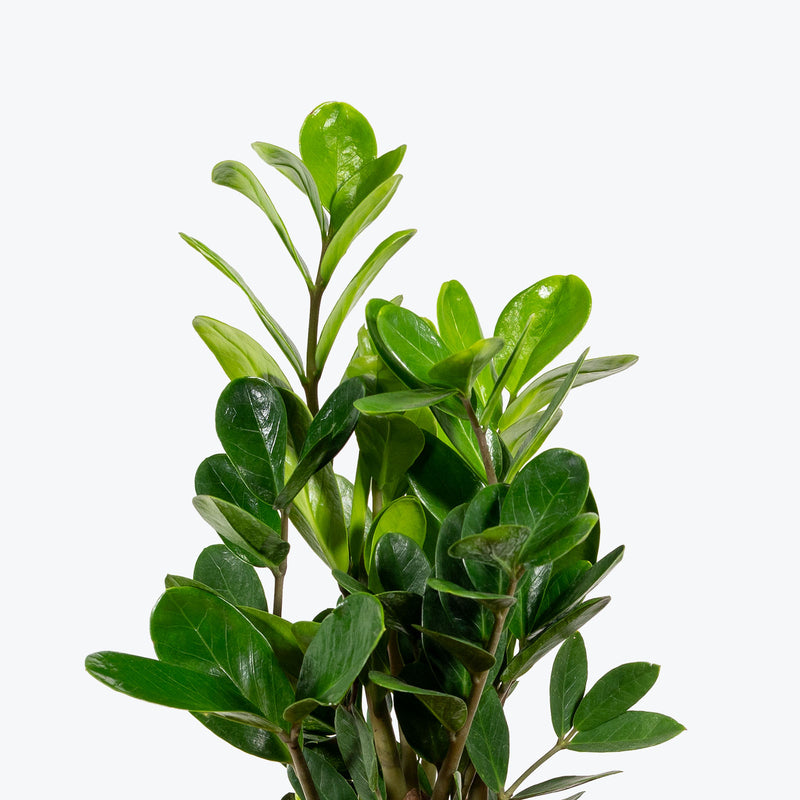
How to care for ZZ Lucky Wide Leaf
ZZ Lucky Wide Leaf should not be in a position to see the sun directly, although early morning or late evening sun is fine. Filtered sunlight through a sheer curtain is best and most homes are comprised primarily of indirect sunlight. The best spot for them is where they do not see the sun during the majority of the day but still get bright, indirect light.
ZZ Lucky Wide Leaf will do well in low light, but will grow faster with brighter light. A low light plant can pretty much survive anyplace inside your home as long as you have a window in the room. Remember, low light does not mean no light and plants will grow based on how much light they receive.
ZZ Lucky Wide Leaf likes the soil to be completely dry before the next watering. This can take up to 4 weeks in an average home environment but it will vary depending on the time of year, your environment and lighting conditions. For them, it's always safer to underwater or water when you see signs of lack of water (i.e. wrinkly or soft leaves). Water a little more often in the warmer months.
Their humidity requirement is low, so do not mist ZZ Lucky Wide Leaf or put them in a terrarium.
They are a slow grower, but as long as you don't put ZZ Lucky Wide Leaf under the sun and don't overwater them, they'll be incredibly low maintenance.
ZZ Lucky Wide Leaf is moderately toxic and can cause some adverse reactions when ingested so it is best to not let your pets eat it, which we advise for all plants in general. The severity of the reaction will depend on how much of the plant is ingested but, if you know your pet typically does not eat your plants, this plant will be suitable for your home..
Learn MoreView PlantZZ Plant
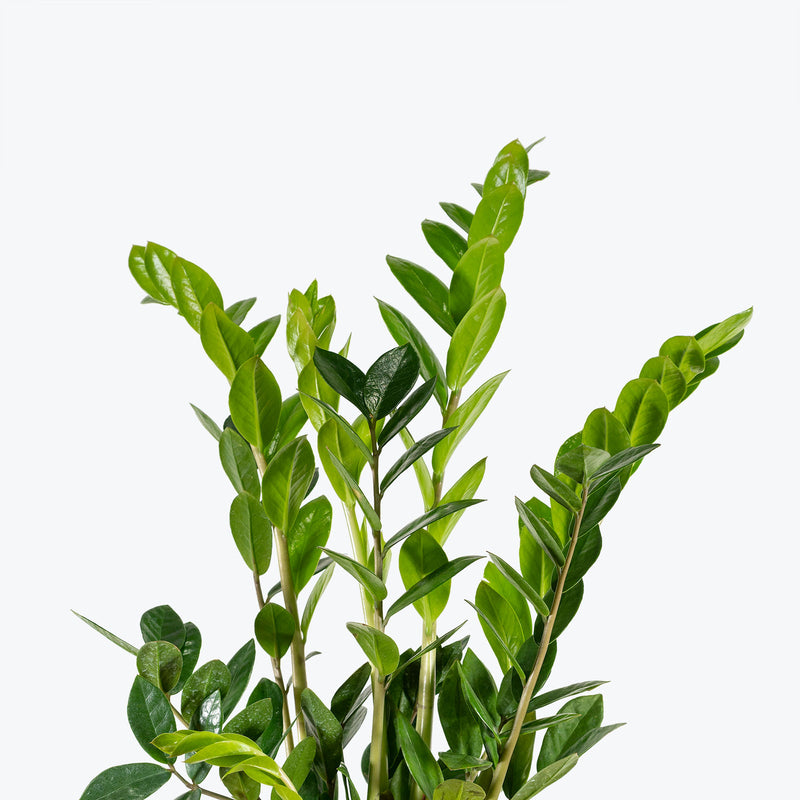
How to care for ZZ Plant
ZZ Plant should not be in a position to see the sun directly, although early morning or late evening sun is fine. Filtered sunlight through a sheer curtain is best and most homes are comprised primarily of indirect sunlight. The best spot for them is where they do not see the sun during the majority of the day but still get bright, indirect light.
ZZ Plant will do well in low light, but will grow faster with brighter light. A low light plant can pretty much survive anyplace inside your home as long as you have a window in the room. Remember, low light does not mean no light and plants will grow based on how much light they receive.
ZZ Plant likes the soil to be completely dry before the next watering. This can take up to 4 weeks in an average home environment but it will vary depending on the time of year, your environment and lighting conditions. For them, it's always safer to underwater or water when you see signs of lack of water (i.e. wrinkly or soft leaves). Water a little more often in the warmer months.
ZZ Plant humidity requirement is low, they don't need to be misted and do not put them in a terrarium.
ZZ Plant is a slow grower, but as long as you don't put them under the sun and don't overwater them, they'll be incredibly low maintenance. It also likes a tight pot and does not need frequent repotting—only once every couple of years or when it becomes extremely root-bound.
ZZ Plant is moderately toxic and can cause some adverse reactions when ingested so it is best to not let your pets eat it, which we advise for all plants in general. The severity of the reaction will depend on how much of the plant is ingested but, if you know your pet typically does not eat your plants, this plant will be suitable for your home..
Learn MoreView PlantZZ Plant Dwarf Zamicro
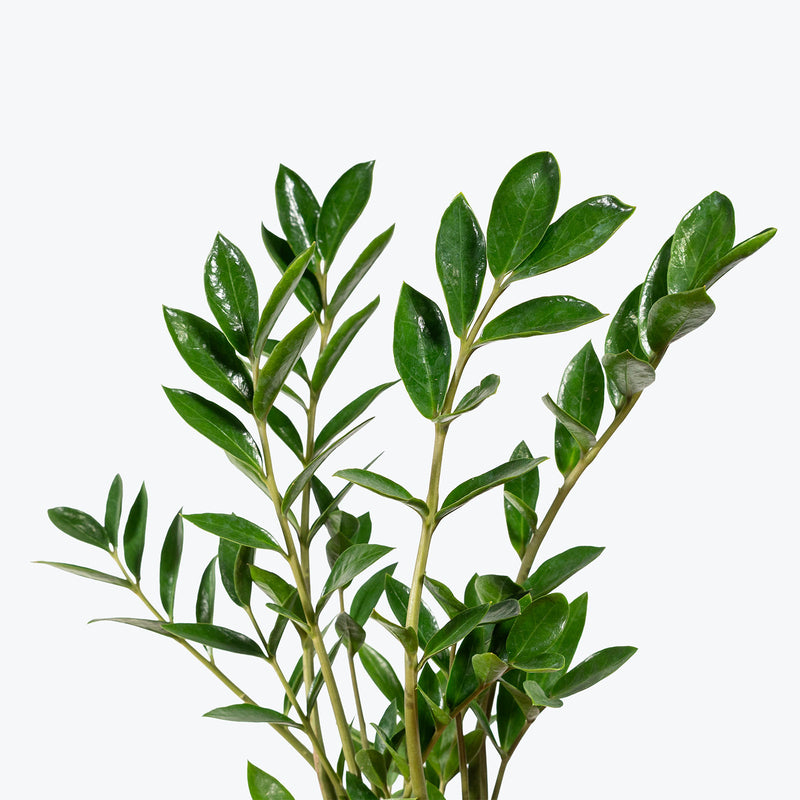
How to care for ZZ Plant Dwarf Zamicro
ZZ Plant Dwarf Zamicro should not be in a position to see the sun directly, although early morning or late evening sun is fine. Filtered sunlight through a sheer curtain is best and most homes are comprised primarily of indirect sunlight. The best spot for them is where they do not see the sun during the majority of the day but still get bright, indirect light.
ZZ Plant Dwarf Zamicro will do well in low light, but will grow faster with brighter light. A low light plant can pretty much survive anyplace inside your home as long as you have a window in the room. Remember, low light does not mean no light and plants will grow based on how much light they receive.
ZZ Plant Dwarf Zamicro likes the soil to be completely dry before the next watering. This can take up to 4 weeks in an average home environment but it will vary depending on the time of year, your environment and lighting conditions. For them, it's always safer to underwater or water when you see signs of lack of water (i.e. wrinkly or soft leaves). Water a little more often in the warmer months.
Their humidity requirement is low, so do not mist ZZ Plant Dwarf Zamicro or put them in a terrarium.
ZZ Plant Dwarf Zamicro is a slow grower, but as long as you don't put them under the sun and don't overwater them, they'll be incredibly low maintenance. Dust the leaves occasionally to keep them shiny and healthy, allowing the plant to photosynthesize efficiently.
ZZ Plant Dwarf Zamicro is moderately toxic and can cause some adverse reactions when ingested so it is best to not let your pets eat it, which we advise for all plants in general. The severity of the reaction will depend on how much of the plant is ingested but, if you know your pet typically does not eat your plants, this plant will be suitable for your home..
Learn MoreView PlantZZ Plant Raven
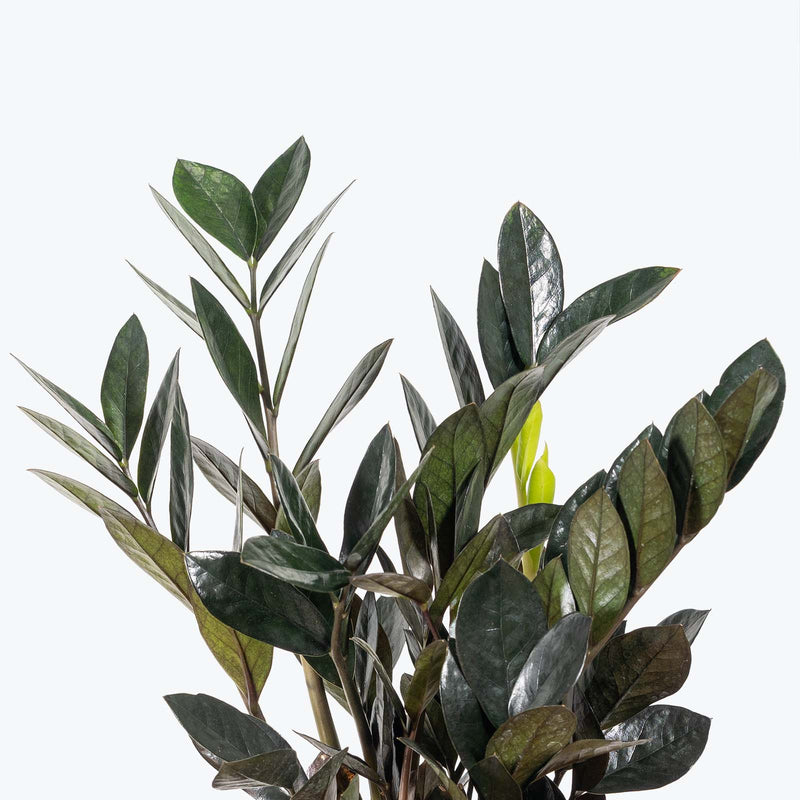
How to care for ZZ Plant Raven
ZZ Raven should not be in a position to see the sun directly, although early morning or late evening sun is fine. Filtered sunlight through a sheer curtain is best and most homes are comprised primarily of indirect sunlight. The best spot for them is where they do not see the sun during the majority of the day but still get bright, indirect light.
ZZ Raven will do well in low light, but will grow faster with brighter light. A low light plant can pretty much survive anyplace inside your home as long as you have a window in the room. Remember, low light does not mean no light and plants will grow based on how much light they receive.
ZZ Raven likes the soil to be completely dry before the next watering. This can take up to 4 weeks in an average home environment but it will vary depending on the time of year, your environment and lighting conditions. For them, it's always safer to underwater or water when you see signs of lack of water (i.e. wrinkly or soft leaves). Water a little more often in the warmer months.
ZZ Raven humidity requirement is low, so do not mist them or put them in a terrarium.
ZZ Raven is a slow grower, but as long as you don't put them under the sun and don't overwater them, they'll be incredibly low maintenance. Wipe its leaves occasionally to remove dust and help the plant breathe better.
ZZ Raven is moderately toxic and can cause some adverse reactions when ingested so it is best to not let your pets eat it, which we advise for all plants in general. The severity of the reaction will depend on how much of the plant is ingested but, if you know your pet typically does not eat your plants, this plant will be suitable for your home..
Learn MoreView PlantZZ Plant Variegated
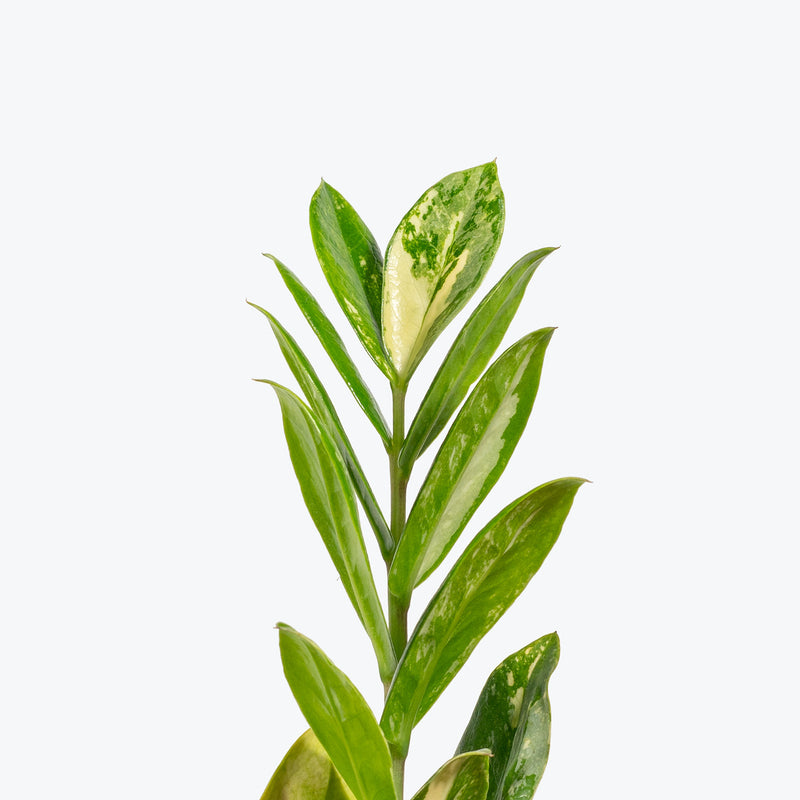
How to care for ZZ Plant Variegated
ZZ Plant Variegated should not be in a position to see the sun directly, although early morning or late evening sun is fine. Filtered sunlight through a sheer curtain is best and most homes are comprised primarily of indirect sunlight. The best spot for them is where they do not see the sun during the majority of the day but still get bright, indirect light.
ZZ Plant Variegated will do well in low light, but will grow faster with brighter light. A low light plant can pretty much survive anyplace inside your home as long as you have a window in the room. Remember, low light does not mean no light and plants will grow based on how much light they receive.
ZZ Plant Variegated likes the soil to be completely dry before the next watering. This can take up to 4 weeks in an average home environment but it will vary depending on the time of year, your environment and lighting conditions. For them, it's always safer to underwater or water when you see signs of lack of water (i.e. wrinkly or soft leaves). Water a little more often in the warmer months.
Their humidity requirement is low, so do not mist ZZ Plant Variegated or put them in a terrarium.
ZZ Plant Variegated is adaptable and can thrive under various lighting conditions. However, too little light may cause the variegation to fade and the growth to slow down. Due to its slow growth, the Variegated ZZ Plant rarely needs repotting. Only consider repotting if the plant has outgrown its current pot, generally every 2-3 years.
ZZ Plant Variegated is moderately toxic and can cause some adverse reactions when ingested so it is best to not let your pets eat it, which we advise for all plants in general. The severity of the reaction will depend on how much of the plant is ingested but, if you know your pet typically does not eat your plants, this plant will be suitable for your home..
Learn MoreView PlantZZ Plant Zamicro Black
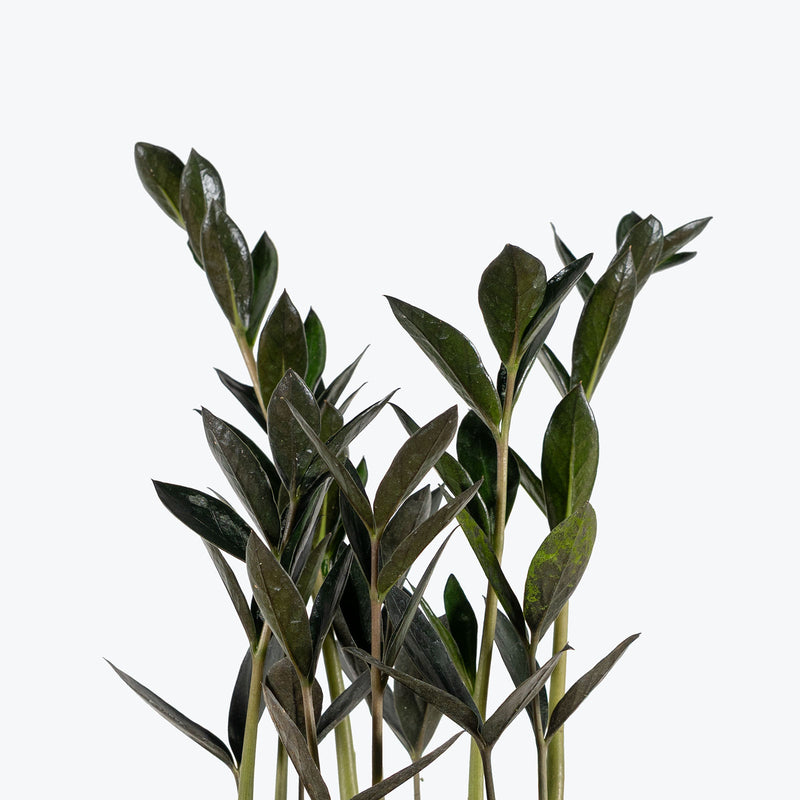
How to care for ZZ Plant Zamicro Black
ZZ Plant Zamicro Black should not be in a position to see the sun directly, although early morning or late evening sun is fine. Filtered sunlight through a sheer curtain is best and most homes are comprised primarily of indirect sunlight. The best spot for them is where they do not see the sun during the majority of the day but still get bright, indirect light.
ZZ Plant Zamicro Black will do well in low light, but will grow faster with brighter light. A low light plant can pretty much survive anyplace inside your home as long as you have a window in the room. Remember, low light does not mean no light and plants will grow based on how much light they receive.
ZZ Plant Zamicro Black likes the soil to be completely dry before the next watering. This can take up to 4 weeks in an average home environment but it will vary depending on the time of year, your environment and lighting conditions. For them, it's always safer to underwater or water when you see signs of lack of water (i.e. wrinkly or soft leaves). Water a little more often in the warmer months.
Their humidity requirement is low, so do not mist ZZ Plant Zamicro Black or put them in a terrarium.
ZZ Plant Zamicro Black is generally low-maintenance but benefits from occasional leaf cleaning to remove dust and enhance its glossy appearance. Be cautious not to overwater, as this can lead to root rot.
ZZ Plant Zamicro Black is moderately toxic and can cause some adverse reactions when ingested so it is best to not let your pets eat it, which we advise for all plants in general. The severity of the reaction will depend on how much of the plant is ingested but, if you know your pet typically does not eat your plants, this plant will be suitable for your home..
Learn MoreView PlantZZ Plant Zenzi
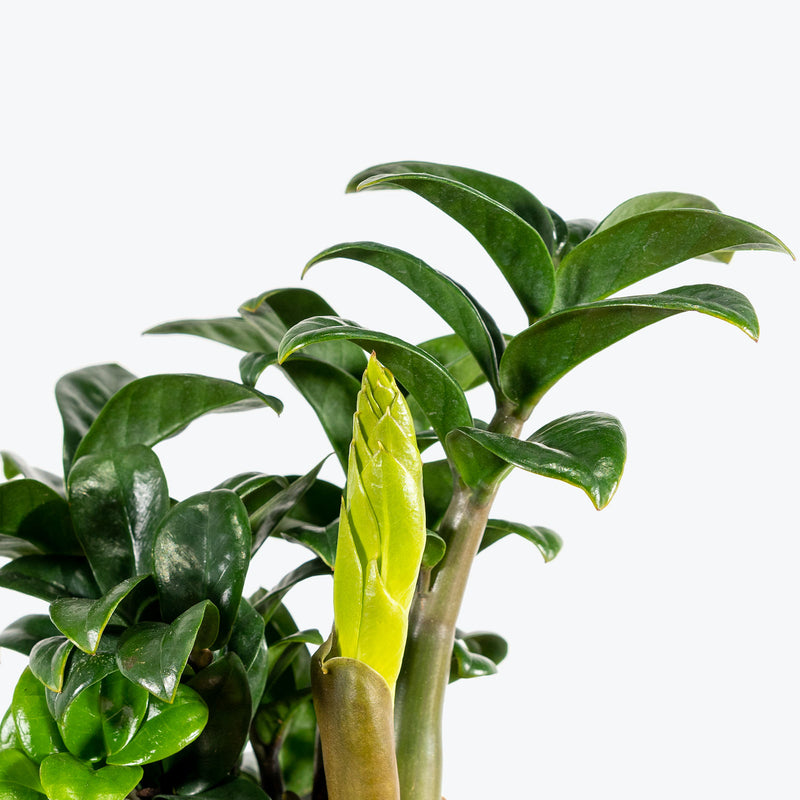
How to care for ZZ Plant Zenzi
ZZ Zenzi should not be in a position to see the sun directly, although early morning or late evening sun is fine. Filtered sunlight through a sheer curtain is best and most homes are comprised primarily of indirect sunlight. The best spot for them is where they do not see the sun during the majority of the day but still get bright, indirect light.
ZZ Zenzi will do well in low light, but will grow faster with brighter light. A low light plant can pretty much survive anyplace inside your home as long as you have a window in the room. Remember, low light does not mean no light and plants will grow based on how much light they receive.
ZZ Zenzi likes the soil to be completely dry before the next watering. This can take up to 4 weeks in an average home environment but it will vary depending on the time of year, your environment and lighting conditions. For them, it's always safer to underwater or water when you see signs of lack of water (i.e. wrinkly or soft leaves). Water a little more often in the warmer months.
Their humidity requirement is low, so do not mist ZZ Zenzi or put them in a terrarium.
Fertilize ZZ Zenzi with a balanced liquid fertilizer diluted to half strength once or twice a year during the growing season. There is no need to fertilize during winter when growth naturally slows. Dust the leaves occasionally to maintain their shine and health. Due to its compact size, Zenzi ZZ rarely requires repotting. They are a slow grower, but as long as you don't put them under the sun and don't overwater them, they'll be incredibly low maintenance.
ZZ Zenzi is moderately toxic and can cause some adverse reactions when ingested so it is best to not let your pets eat it, which we advise for all plants in general. The severity of the reaction will depend on how much of the plant is ingested but, if you know your pet typically does not eat your plants, this plant will be suitable for your home..
Learn MoreView Plant